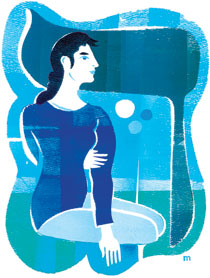Issue Archive
Commentary: Stretching Tradition

Thirty students sat cross-legged on mats in a gym at the University of Virginia one Shabbat trying out Torah Yoga.
Some were tentative. How comfortable would they feel about a practice that fused body poses and Torah study, they probably asked themselves. Would it feel authentically Jewish? Other students only watched from the sidelines.
“Shabbat shalom,” our leader, Mimi, a junior who had been my student, greeted us. She said we would experience how the Torah reading — about Moses creating a portable sanctuary in the wilderness (Shemot: Vayakhel-Pekudei)—could inspire us to create sacred space in our lives.
Mimi wisely drew on techniques Jewish leaders turn to when they introduce new rituals. There was precedent and authority: Mimi assured us that the founders of the Torah Yoga movement were a rabbi, Myriam Klutz, and a Torah scholar, Diane Bloomfield. There was a text, Bloomfield’s Torah Yoga (Jossey-Bass), which Mimi held up for us to see.
She also used the authenticating power of Hebrew and Jewish imagery: “Eitz hayim, the tree of life,” Mimi said, as we posed like a tree, and she suggested we consider how Torah and generational bonds were the source of our Jewish roots.
New jewish rituals can make us feel uncomfortable, even when we want to embrace them. When I attended my first baby-naming ceremony for a girl and my first Orthodox service in which women led prayers and read from the Torah, I worried: Would the new practice ever feel “naturally” Jewish to me? Could I ever get used to seeing a Seder table set with a Miriam’s Cup or a woman wearing a talit and kippa? Of course, such practices are now well-established customs in certain communities.
And as new practices become regularized in format and widespread, we may even come to treasure those that start to feel traditional—as beloved, familiar and necessary as lighting candles on Hanukka, a ritual about which rabbis originally debated why and how it should be done.
One way we can ensure our faith remains vibrant under challenging situations is by having the courage to change old traditions or introduce new ones. To reinterpret Lamentations (5:21), hadesh yameinu, let there be renewal in our days. Thus, the creation of Israel necessitated innovating a Prayer for the State of Israel and a new holiday, Yom Ha’atzma’ut (Israel Independence Day). Feminism has inspired egalitarian Orthodox synagogues. Just as there are pious guardians of the past, there are pious agents of change who are willing to put up with the discomfort of novelty and experimentation to preserve Judaism as a living tradition.
Will Torah Yoga establish itself at my university? Hard to guess. Who knew that practices introduced in the last decade, such as women’s Rosh Hodesh gatherings and a 24-hour Holocaust Remembrance Day recitation of the names of those who perished under the Nazis, would become established traditions here?
When Jews of the past introduced new rituals, they were often contested, especially if they showed the influence of other cultures. Tashlikh—symbolically throwing sins into a body of water on Rosh Hashana—was not universally accepted because some declared it a heathen practice. But over time, the innovation was embraced.
“Really cool,” said one student as she struggled to stand after the final restful posture of our Torah Yoga class. As even the most challenging yoga postures begin to feel natural with practice, I supposed we would be easing into Torah Yoga again.
Vanessa L. Ochs’s latest book is Inventing Jewish Ritual, published by the Jewish Publication Society.










 Facebook
Facebook Instagram
Instagram Twitter
Twitter
Leave a Reply